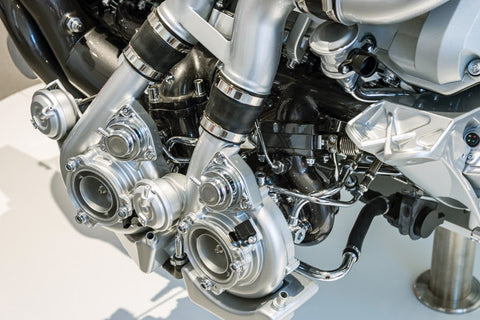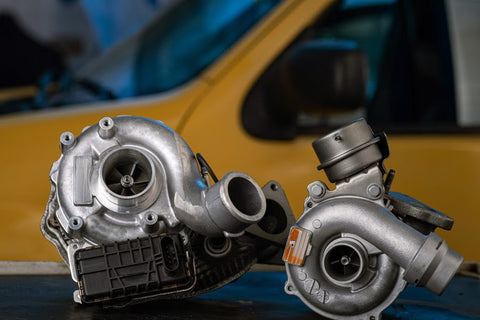You are most certainly familiar with turbocharged vehicles. But have you heard about the twin turbo? We wouldn’t leave you wondering about it if we grabbed your attention. So, what is twin turbo? What does twin turbo mean?
In our comprehensive guide, you will find everything you need to know about twin turbo. We will start by explaining what twin turbo means so we can dig deeper into the topic and list the pros and cons, twin turbo types, and common applications.

Source: shutterstock.com / Photo Contributor: GaiBru Photo
What Is Twin Turbo?
Twin turbo is a type of engine layout. It uses two turbochargers to compress the intake air or fuel/air mixture. The purpose of using a twin turbo is to increase your vehicle's performance, power, and even fuel efficiency.
The two turbos are typically mounted to the engine's exhaust and connected with the air induction. The turbos in the setup can be either identical or different. If they are the same or mirroring turbos, they will be the same size, model, and specifications. We've seen many cases when the turbos are a different size.
One expert tip: Don't confuse a twin turbo with a twin charger. They are not the same. We have many clients who mix up the two arrangements. As you already know what a twin turbo is, we will explain the twin charge setting shortly.
Twincharging is a combination of turbochargers and superchargers. It has the exhaust-driven features of a turbocharger and is mechanically driven as a supercharger.
Twin turbo advantages
Twin turbo engines offer many benefits. Compared to single turbos, they are more powerful. In addition, they don’t take up as much space because they are typically smaller in size by offer exceptional power. Also, during the installation process, less exhaust piping is used.
Furthermore, the fuel economy may be improved when two turbochargers work in tandem, as in twin turbo settings. One of the main reasons is that the two turbos lower the chances of turbo lag.
The reduced lag time may contribute to optimal performance. Instead of needing eight cylinders like single turbos, the twin-turbo setup can use only four cylinders to produce power faster.
Another advantage of twin turbos is that they can ensure even engine functionality. If the twin turbos are correctly dialed in, they will work together intuitively and effectively.
Twin turbo disadvantages
Adding a twin turbo requires a significant amount of space in the engine bay. Although it is not considered a disadvantage by all, we have certain clients who think it is too much.
In addition, because of the two turbochargers that need to be placed, twin turbos might cost you more to install than turbochargers. Another risk is that if it is not installed and tuned properly, the twin turbo may increase the potential for engine damage.
However, you shouldn’t consider only the installation costs. Also, the two turbochargers need unique upkeep requirements that can be pricey.
How Does a Twin Turbo Engine Work?
The two turbochargers work in conjunction with the engine cylinders. The exhaust gases drive them and compress the air, forcing it into the engine’s intake.
A twin turbo allows more air to mix with fuel, contributing to better combustion. Simply put, it can provide quicker acceleration and improved overall performance compared to a naturally aspirated engine.
Types of Twin Turbo Systems
The twin turbo systems can have three different turbine setups: parallel, sequential, and series. Each turbine setup up can be applied with five compressor types:
- Compound
- Stage compound
- Staged sequential
- Parallel sequential
- Parallel compressors
Parallel twin turbo
In a parallel twin turbo setting, both turbochargers are equal in size. They are designed so that each can get half of the total engine exhaust gases. Parallel twin turbos are known for their capabilities to reduce turbo lag.
In the automobile industry, we refer to the parallel twin turbo as the easiest to install and tune. They require minimal exhaust piping and are surprisingly efficient and cost-effective for their compact size.
Within this category, there are two types of designs. The first is where the intake from the two turbocharges is combined in one intake manifold. On the other hand, the other parallel twin turbo design with two separate intake manifolds, one for each turbocharger.

Sequential twin turbo
In sequential twin turbos, each turbocharger has a single purpose. One is used when the vehicle moves at low engine speeds, while the other works at high, or sometimes both. The twin turbos work together, and as the RPM increases, the secondary turbocharger gets more exhaust gases.
In the industry, the sequential twin turbos are used to overcome superior power and responsive agility. However, the downside of sequential twin turbos is that they are complex engine types. They require proper maintenance and might not be too reliable.
Series twin turbo
As the name implies, the series twin turbo has two turbochargers in sequence. Consequently, they are also called two-stage twin turbos. The first turbocharger is responsible for the initial compression.
Then, the compressed gases are transferred to the second turbo, where they are further compressed. Series twin turbos can produce exceptional air compression, resulting in huge pressure and power boosts.
Applications of Twin Turbo
The application of the twin turbo depends on the type. For instance, a parallel twin turbo is most suitable for vehicles with V6 and V8 engines. They are also commonly applied to flat engines with multiple-cylinder banks.
On the other hand, a sequential twin turbo was used in the past on cars such as the Toyota Supra, Porsche 959, and Mazda RX-7 Mk3. Unfortunately, with the evolution of modern technology, the sequential twin turbo is rarely used today. They are costly to make and complex to install, requiring a lot of pipes.
Lastly, series twin turbos are used in piston-engine aircraft and high-performance diesel engines. Their applications are limited because they are used to generate larger boost levels at lower RPM.
Expert Tips Before Installing a Twin Turbo
Before enjoying the added power and ultimate performance, you should consider some things. First, if you add turbochargers for sale to your current engine, you should have in mind the installation costs. Although many car enthusiasts like to do that alone, we recommend hiring a professional.
They can guide you through the process and offer you some expert advice. Also, you will get a unique quote according to the engine size, car type, and the performance you want to achieve.
Moreover, you should only install a twin turbo if you plan to upkeep and maintain it. This way, you can enjoy the benefits of a twin turbo and avoid any malfunctions.
Remember that other vehicle components should also be checked to see whether they can handle the extra power twin turbos provide. Parts like driveshafts, transmissions, clutches and differentials should be a priority. In addition, you should add high-performance spark plugs and upgrade your fuel injection system.

Source: shutterstock.com / Photo Contributor: Sherbak_photo
Frequently Asked Questions
Is a twin-turbo the same as a biturbo?
Yes, twin turbo and biturbo are used for the same engine type. It is a matter of preference which one will the vehicle brand choose. Yet, they both represent an engine type that has two turbochargers.
How much hp is a twin turbo?
Multiple factors determine how much HP the twin turbo adds, such as turbo size, boost level, modifications, and the engine's compression ratio. Twin turbos can add up to an engine from 50 to more than 1,000 hp.
Are twin turbos worth it?
Whether twin turbos are worth it depends on what you want to achieve. Twin turbos are the right choice to boost your engine performance and increase power output and efficiency. The worthiness of the twin turbos depends on your driving needs, vehicle design, and, most importantly, how you use it.
Conclusion
What is twin turbo? As one of the setups that offers a vast array of benefits, we want our current and potential clients like you to know their options. To recap, it is an engine with two turbochargers that operate together to compress the intake fuel/air combination.
If you decide to install one in your diesel vehicle, we are more than happy to help you find the most suitable twin turbo. We offer both new and rebuilt twin turbos that might help you increase your engine's power and performance.


